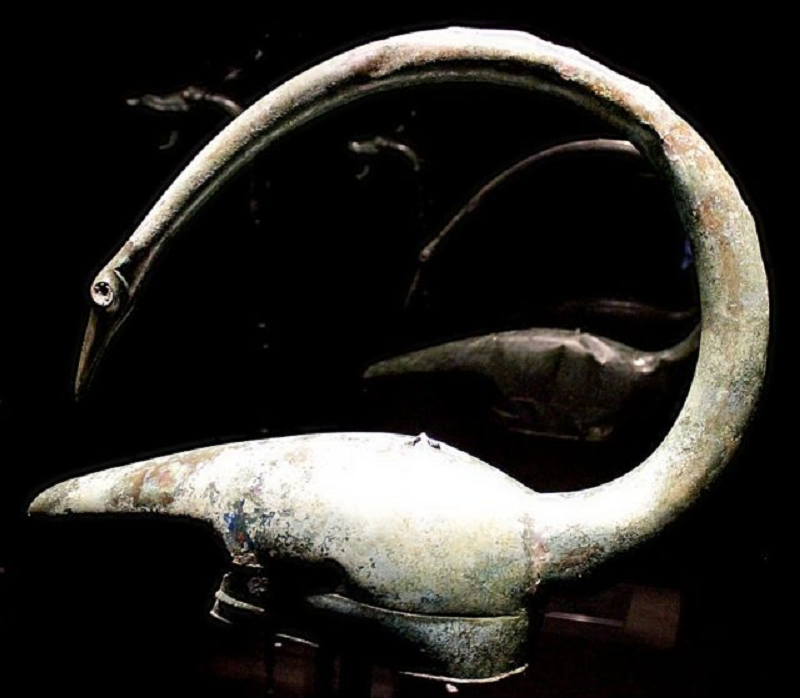In the quiet commune of Tintignac, France, nestled amidst the lush greenery of the Corrèze region, lies an archaeological treasure trove that has captivated the world’s imagination: a Gallic bronze helmet fashioned in the shape of a majestic swan. Unearthed by archaeologists in 2004, this exquisite artifact from the 4th to 2nd century BCE offers a tantalizing glimpse into the rich cultural tapestry of ancient Gaul. Join me as we delve into the intriguing tale of this remarkable discovery and explore the mysteries it unveils.
The Unearthing of the Swan Helmet: The story begins with a team of archaeologists embarking on a quest to unearth the secrets of Tintignac’s past. Armed with spades and brushes, they meticulously excavated the site, sifting through layers of history buried beneath the earth. Then, amidst the rubble and sediment, they stumbled upon a breathtaking find: a Gallic bronze helmet crafted in the likeness of a swan.
Symbolism and Significance: The swan, revered in Celtic mythology for its grace and beauty, holds a prominent place in Gaulish culture. Its appearance on this helmet suggests a deep connection to the spiritual beliefs and rituals of the ancient Gauls. Some scholars theorize that the helmet may have been worn by a prominent warrior or chieftain during ceremonial gatherings or battles, serving as a symbol of power and prestige.

Artistry and Craftsmanship: What truly sets this helmet apart is its exquisite craftsmanship. Meticulously crafted from bronze, the helmet features intricate details that attest to the skill and artistry of its maker. The swan’s elegant neck curves gracefully to form the helmet’s crest, while delicate feathers adorn its surface, adding a touch of splendor to its design. Such meticulous attention to detail showcases the Gauls’ mastery of metallurgy and their reverence for beauty in both art and war.
Cultural Context: To understand the significance of the swan helmet, we must delve into the cultural milieu of ancient Gaul. The Gauls, a Celtic people who inhabited present-day France and surrounding regions, possessed a vibrant and complex society characterized by a rich tapestry of traditions, beliefs, and artistic expressions. The discovery of the helmet at Tintignac provides a rare glimpse into this ancient world, shedding light on the Gauls’ customs, rituals, and military prowess.
Legacy and Preservation: Since its discovery, the Gallic swan helmet has become a symbol of pride and heritage for the people of Tintignac and France at large. It serves as a tangible link to the past, reminding us of the resilience and ingenuity of our ancestors. Efforts to preserve and study the artifact continue to this day, ensuring that future generations will have the opportunity to marvel at its beauty and unravel the mysteries it holds.

The Gallic swan helmet unearthed at Tintignac, France, is nothing short of a masterpiece of ancient craftsmanship. Dating back to the 4th to 2nd century BCE, this helmet is a stunning example of the Gauls’ mastery of metallurgy and their reverence for both art and warfare.
Upon first glance, the helmet’s design is striking. Fashioned from bronze, its elegant form mimics that of a swan, with a gracefully curved neck extending to form the helmet’s crest. Delicate feathers adorn its surface, adding a touch of splendor to its overall appearance. The attention to detail is truly remarkable, showcasing the skill and artistry of its ancient creator.
Beyond its aesthetic appeal, the swan helmet carries profound symbolism. In Celtic mythology, the swan holds a sacred significance, representing grace, beauty, and otherworldly wisdom. As such, the presence of the swan motif on this helmet suggests a deeper connection to the spiritual beliefs and rituals of the ancient Gauls. It is not merely a piece of protective gear but a symbol of power and prestige, likely worn by a prominent warrior or chieftain during ceremonial gatherings or battles.

The discovery of the Gallic swan helmet at Tintignac provides invaluable insights into the cultural and artistic achievements of ancient Gaul. It serves as a tangible link to the past, offering a glimpse into the customs, beliefs, and military practices of this enigmatic civilization. Moreover, its preservation and ongoing study ensure that its legacy will endure for future generations to appreciate and explore.
In conclusion, the Gallic swan helmet of Tintignac is a true archaeological treasure—a testament to the ingenuity, skill, and artistic sophistication of the Gauls. Its beauty captivates the imagination, while its historical significance enriches our understanding of the ancient world. Whether viewed as a work of art or a piece of military equipment, this remarkable artifact continues to inspire wonder and fascination, inviting us to embark on a journey through the annals of time.
Conclusion
The discovery of the Gallic swan helmet at Tintignac stands as a testament to the enduring allure of archaeology and the boundless depths of human history. In its graceful contours and intricate details, we find echoes of a bygone era—a time when the Gauls roamed the land, their stories etched in bronze and buried beneath the earth. As we gaze upon this ancient artifact, let us not only marvel at its beauty but also reflect on the rich cultural heritage it represents. For in the annals of time, the swan helmet of Tintignac shall forever remain a beacon of our shared past and a testament to the enduring spirit of discovery.


